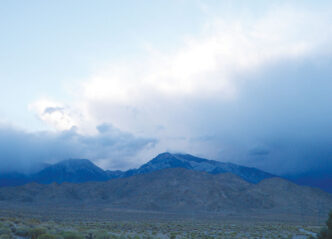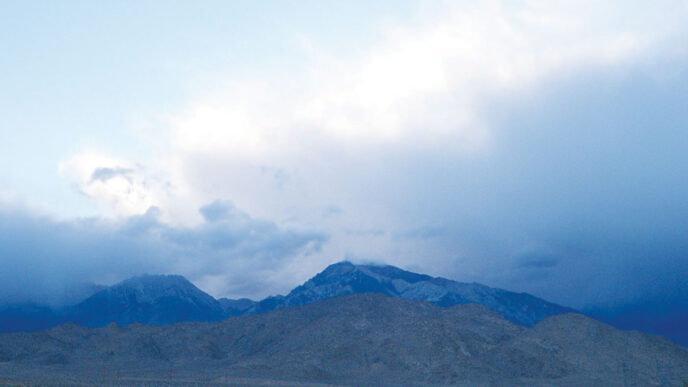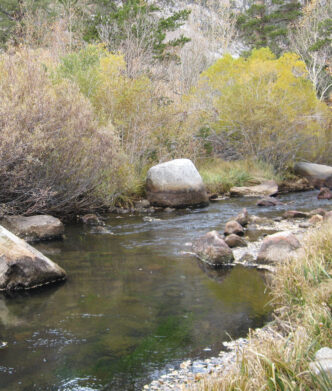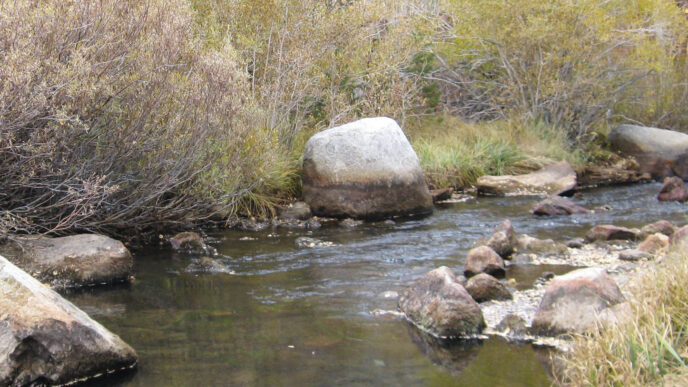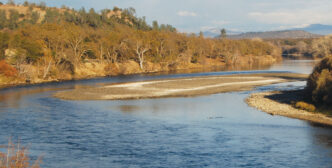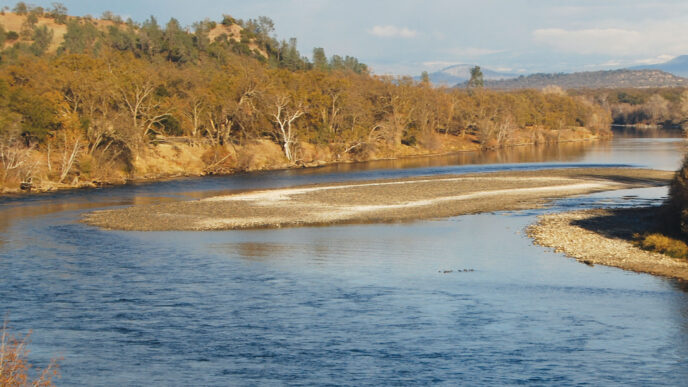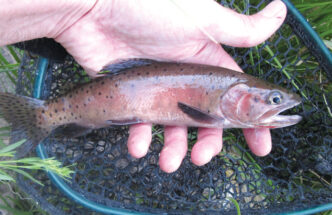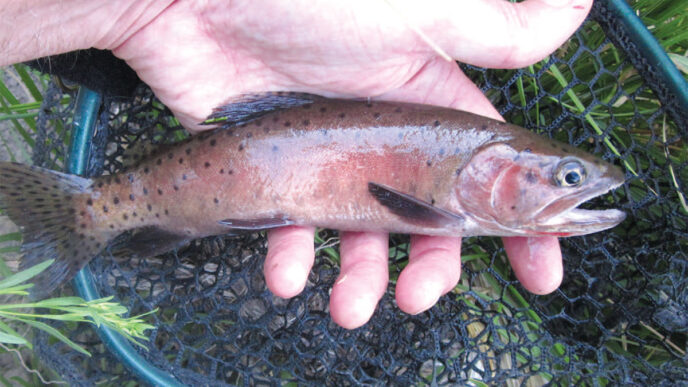Editor’s note: Although “The Foraging Angler” column typically focuses on the quest for sustenance and the dining experience when angling, in a broader sense, the verb “forage” simply means “to make a search.” In this issue’s column, foraging for tackle leads us into a finer appreciation of history and the stories of family.
I am relatively new to my adopted community in the Sierra foothills. When the phone rang with a request to give a sort of “Antique Road Show” appraisal of a local woman’s great-great-grandfather’s antique fly-fishing equipment, I jumped at the chance. It could mean the discovery of a museum-quality antique, the chance to purchase a treasure, or it could be a bust, with nothing more than a tour through boxes of old junk. Opportunities like this have diminished with the onslaught of Craigslist, eBay, and the publication of books that catalogue and sell old fishing tackle. Remarkable finds are fewer and farther between now that it is easier for people to know what they have.
I learned about antiques in the late 1960s and early 1970s. My wife and I would leave our new home in the East Bay several times a month and drive routes that took us along the back roads of Northern California. We headed south to Mission San Jose, San Juan Bautista, and Salinas. A northern route took us through the wine country and to the metropolises of Sonoma, Sebastopol, and Healdsburg. Sometimes it was Napa, Calistoga, or Saint Helena. Nearer to our home were the backwater villages of Benicia and Crockett. Our eastern route led to the western Sierra and the southern Mother Lode. We scoured antique stores and the grimy back rooms of secondhand furniture dealers in Mariposa, Angels Camp, San
Andreas, Mokelumne Hill, Sutter Creek, Jackson, Placerville, and Auburn for affordable antiques to furnish my newly acquired Victorian office building. A second goal for me was to find historical fly-fishing literature or fly-fishing equipment that might be lying undiscovered and unappreciated, leaning against a wall in a corner of a weathered Gold Rush–era building.
I rummaged through thousands of old books that I found in dusty cardboard boxes and on sagging backroom shelves in the Gold Rush towns reached via Highway 49. I discovered Dr. James A. Henshall’s Book of the Black Bass, Charles McDermond’s Waters of the Golden Trout Country, Izaak Walton’s Complete Angler, Henry van Dyke’s Fisherman’s Luck, and Francis Parkman’s California and Oregon Trail. With gold came the opera, architecture, and literature. California’s Argonauts acquired classics written in the eastern United States and Europe and treasured them. They also produced their own writers, painters, craftsmen, and entertainers. A rich legacy was still to be found in the Mother Lode. For me, it was an education that moved forward from shelf to shelf and store to store.
The lady who contacted me about the antique rods was new to the area, as well. She was a minister and had been asked by a young nephew if she would become the caretaker of some treasures that had been inherited from an uncle on the East Coast. When I called to set up a meeting, I asked some basic questions: “Are the rods intact? Describe the thread windings that hold the line guides on the rod. Are there any markings or engraving on the metal parts? What kind of metal does it look like? Is it a rich silver, or cheap chrome? What does the handle look like? Is it made of cork or spiral wood wrappings? Might it be black and of a plastic-like material? Is there a case, and does it look old?”
These questions can help an appraiser cull out the “Occupied Japan” rods in the little wooden boxes that came home with many a G.I. from the Korean War or save a trip on the freeway to see the nightmare of a Union Hardware telescoping rod.
The answers to all my questions passed the test and stirred my curiosity. The woman said that the rods were in a four-inch-diameter leather case that had brass buckles, a cap on one end, and a carrying strap that was similar to a gun sling. She went on to tell of a worn, oil-polished patina on the leather and that it looked like it held something important.
Three days later, directions given on the phone led me to the entrance of a wooded estate on Harmony Ridge above Nevada City. My hostess greeted me and directed me to sit in a wooden chair that was one of several arranged on a natural stone terrace set among cedars. The tree limbs were trimmed up 20 feet or more and allowed a view across the veranda and over the crest toward the Sutter Buttes situated 45 miles to the north.
My hostess excused herself, but returned quickly with coffee and a leather case . . . and something else that was wrapped in a blanket. What might that hold? She sat down, poured the steaming beverage into a Spode cup, and began to talk. She had recently acquired the relics from her East Coast nephew because he thought she would be the best family custodian. She did not know a lot about her great-great-grandfather, but was making inquiries. What she found out follows.
Her ancestor was a Union Army cavalry officer during the Civil War. He belonged to a regiment that was organized in Maine. As a young man, he served with distinction and escaped the bloody war with his limbs intact. He then returned home and started a successful business. Little has survived that tells of his life, other than his love of the outdoors and his passionate obsession with the sport of fly fishing.
I questioned my hostess as I carefully removed the cap from the leather case. A faded olive cloth rod sack encased the treasures. The sack was crammed full and would not pull out of the leather case easily. Several rods had been stuffed into the case. I twisted and gently tugged, fearful of tearing the time-worn fabric, and gingerly worked out a long, hollow bamboo cylinder that had a knurled silver cap on one end. Once removed, this released the sack that held the rods. There were five stitched compartments. Two held rod butt sections. One had a cork reel seat similar in design to the half-well grips that are seen today on quality rods. It was the lighter rod of the two, which might equate with a modern 6-weight. The other had spiral wooden windings of a cane material on the handle similar to those seen on the larger twohanded rods of that era. It was similar in that it had three sections, but was at least a 9-weight rod and would have been used for taking heavier fish, perhaps the Atlantic salmon for which Maine was famous before the environmental degradation of its rivers.
The other three compartments held multiple, more delicate middle and tip sections. The silver ferules of the midsections held silver plugs that were serrated for gripping and twisting. There were tip sections of different diameters and flexibilities for both rods. The bamboo cylinder had a burnt patina from fire hardening and held more tip sections, including one that was not varnished and that had been crudely fitted with a chromed tip top. Unlike the oval tip guides that point groundward on today’s rods, these were topped by round rings that were soldered to four wires that extended from the metal sleeve.
Swinging brass guides were held on by varnished thread. The rods were six-sided, and the glue was reinforced by thin red silk wrappings every two inches. The planing was true, and the cane showed the same fire marks seen on the hollow bamboo tip container. As my hostess had said on the phone, there was a lack of engraving or other identification on the metal ferrules and reel seats that would have identified the rod maker. She suggested that she thought the rods were built by her relative, the Union Army officer. If so, they were very professional and suggested he was a perfectionist.
It became obvious that an entire flyfishing system was encased in the leather carrying case. The actions of both rods could be modified by choosing different tip sections. There were replacement tips for both rods, each with different diameters. Tip breakage in that era was common with the thin diameters that gave needed flex. Today, extra intact tips increase the value of any collectable rod. The unvarnished tip suggested a field repair. I concluded that the rods were crafted in the 1870s or 1880s by an extremely meticulous, knowledgeable angler.
In my forays through the Sierra, I had found and restored a number of bamboo rods. Mentors in my local fly-fishing club increased my knowledge and respect for these beautiful, hand-crafted angling tools. It was lust and folly for me to fish them, because I broke the single tips on wild trout. They now adorn a spot above the fireplace mantle of my mountain home. The repairs are invisible, but unserviceable. I told my hostess that her great-great-grandfather was a sophisticated fly angler for the post–Civil War era. His equipment spoke of a man who took his sport seriously and of a man who prepared in a very thorough fashion.
At that point, my hostess unrolled the faded, tattered blanket. Two swords lay on the aging fabric. I was stunned and felt a pang in my chest, for at one time, I had carried a ceremonial sword, and the memories flashed through my mind. A look at the two swords told us more. A fancy one with faded gold braid, tassel, and engraving was a dress embellishment for parades and government ceremonies. It spoke of a man of means, high rank, and influence. A stouter, workmanlike sword was meant for battle. Stained nicks along the cutting edge hinted of encounters and horrors that men and generations try to forget.
The interview with my hostess proceeded, and I found that this gentleman was from the Rangeley Lakes region of Maine. One rod must have been for swinging a wet fly from the stern of the kind of wooden fishing skiff for which the region was famous, trolling while a guide pulled on the oars. My books saved from the dusty shelves of the Mother Lode told of the famous wet flies of Maine and the legendary pools there that held great brook trout. A prized oil painting found in a Gold Country estate sale depicts a magnificently colored orange-and-red brook trout lying in damp grass beside a rock-filled babbling brook. The angler’s rod lies in the lush green foreground, and the polished engraving of the German nickel silver reel seat flashes alongside the trout scales and the brilliance of a bright red streamer fly.
I told my hostess that we needed to know more about this man who was her great-great-grandfather. What was his regiment, and where did he fight? Was he wounded? What did he see that made him want to return home and spend his time on the great waters? Would she call or write and ask if there are letters or a journal that would tell us more of the story? Might there be reels and a flybook somewhere? What happened to the family?
I hope someday I will be able to tell you more.
Cafe Collage
Oregon House, California
When Jeanne Romero resubscribed recently, she added a note, “Cafe Collage for after fishing the lower Yuba. In Oregon House. Geat food, wine.”
That’s not much to go on, but luckily, the restaurant has a descriptive Web page, http://cafecollage.net. Billed as offering “fine Mediterranean cuisine,” the menu lists as signature dishes chicken Provencal, Greek moussaka, and lamb shanks, plus has pizzas, tapas, mezze, dinner salads, and weekly specials. All sound wonderful.
Cafe Collage is located at 13501 Rices Crossing Road, in Oregon House. It is open from 5:30 P.M. to 9 P.M., Thursday through Sunday. Phone (530) 692-2555 for reservations.
Richard Anderson






